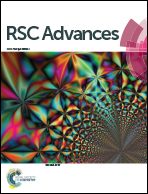Efficient electroluminescent hybridized local and charge-transfer host materials with small singlet–triplet splitting to enhance exciton utilization efficiency: excited state transition configuration†
Abstract
A series of efficient electroluminescent materials with dual carrier transport properties shows enhanced singlet exciton utilization (ηs) due to small singlet–triplet splitting (ΔEST). The strong orbital-coupling transitions of N-(4-(1-(1-(2,3-dihydrobenzo[b][1,4]dioxin-6-yl)-4,5-diphenyl-1H-imidazol-2-yl)naphthalen-4-yl)phenyl)-N-phenyl benzenamine (DDPB) exhibit deep blue emission at 435 nm (CIEy, 0.07) with an external quantum efficiency of 2.01%. The electroluminescent efficiencies of 2-(1-(9H-carbazol-9-yl)naphthalen-4-yl)-1-(2,3-dihydrobenzo[b][1,4]dioxin-6-yl)-1H-phenanthro[9,10-d]imidazole (CDDPI) (L – 3992 cd m−2; ηex – 3.01%; ηc – 2.56 cd A−1; ηp – 2.12 lm W−1) are higher than those of the N-(4-(1-(1-(2,3-dihydrobenzo[b][1,4]dioxin-6-yl)-H-phenanthro[9,10-d]imidazole-2-yl)naphthalen-4-yl)phenyl)-N-phenylbenzenamine (DBDPA) based device (L – 3015 cd m−2; ηex – 2.85%; ηc – 2.01 cd A−1; ηp – 1.92 lm W−1). The blue emissive materials CDDPI and DBDPA are used as a host to construct green and red phosphorescent OLEDs: the green device based on CDDPI:Ir(ppy)3 exhibits higher efficiencies (L – 8812 cd m−2; ηex – 19.0%; ηc – 27.5 cd A−1; ηp – 33.0 lm W−1) at 2.7 V and the red device based on CDDPI:Ir(MQ)2(acac) exhibits a maximum luminance of 39 661 cd m−2 with excellent EL efficiencies [ηex – 19.2%; ηc – 27.9 cd A−1; ηp – 29.2 lm W−1; CIE (0.64, 0.34)] compared with those of the DBDPA:Ir(MQ)2(acac) based device [L – 37 621 cd m−2; ηex – 18.5%; ηc – 25.2 cd A−1; ηp – 25.8 lm W−1; CIE (0.64, 0.34)].



 Please wait while we load your content...
Please wait while we load your content...